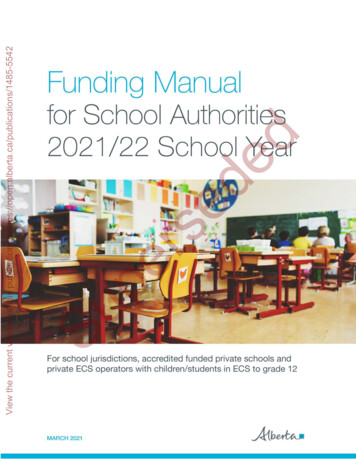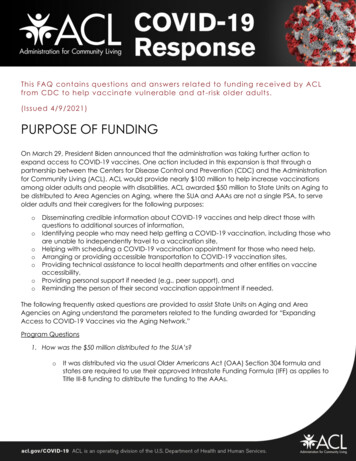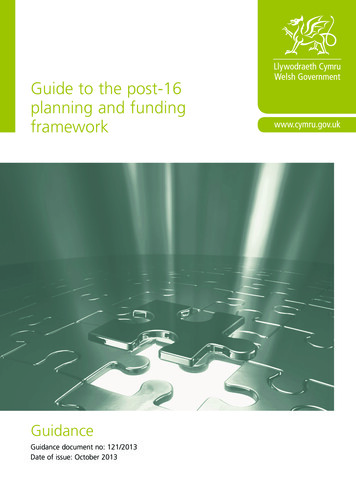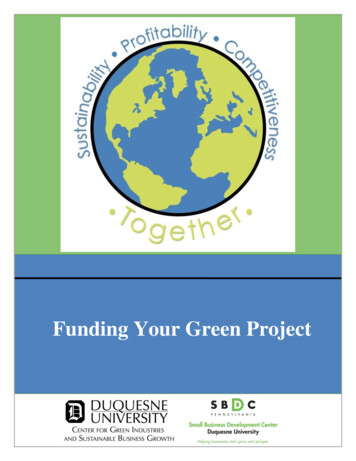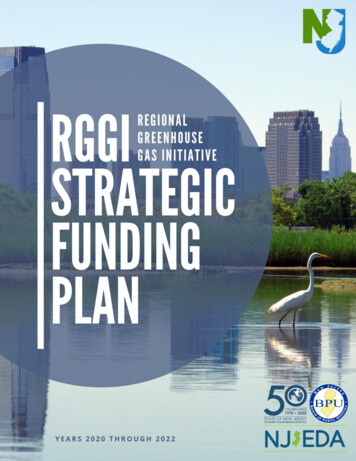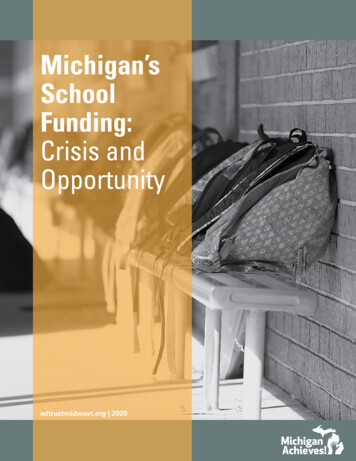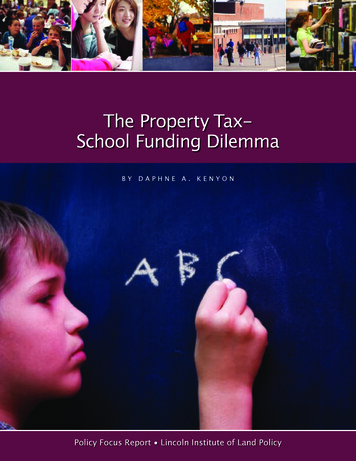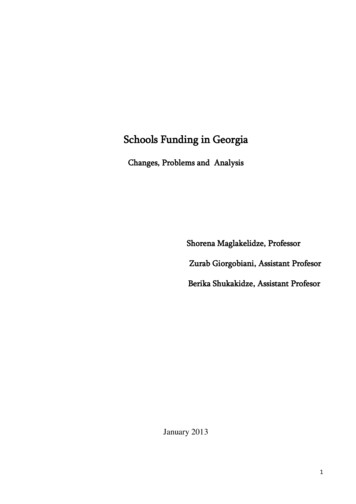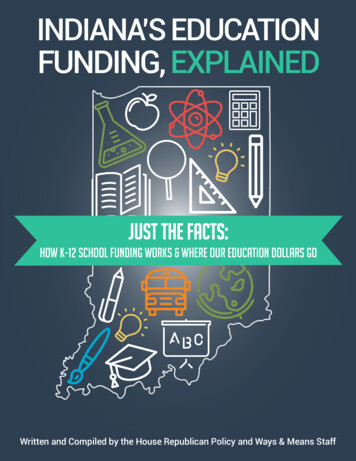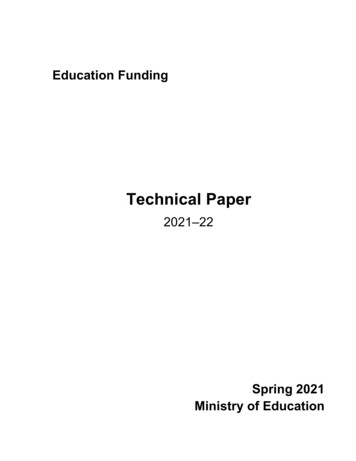
Transcription
Education FundingTechnical Paper02021–22Spring 2021Ministry of Education
Une publication équivalente est disponible en français sous le titre suivant :Financement de l’éducation : Document technique 2021–2022, printemps 2021, sur lesite Web du ministère de l’Éducation.ISSN: 2561-6927 (Online)ISBN: 978-1-4868-4980-2 (PDF)
Table of ContentsTABLE OF CONTENTS . 3INTRODUCTION . 7Purpose . 7Key Changes for 2021-22 . 7Further Information . 8Education Funding Grants . 9PUPIL FOUNDATION GRANT . 12Pupil Foundation Grant Components . 13SCHOOL FOUNDATION GRANT . 22Definition of “School” . 22In-school Administration and Leadership Allocation . 23Library Staff Allocation . 28Parent Engagement Allocation . 28SUPPLEMENTAL GRANTS . 29SPECIAL EDUCATION GRANT . 30Special Education Per-Pupil Amount (SEPPA) Allocation . 31Differentiated Special Education Needs Amount (DSENA) Allocation. 31Special Equipment Amount (SEA) Allocation . 45Special Incidence Portion (SIP) Allocation . 47Education and Community Partnership Program (ECPP) Allocation . 47Behaviour Expertise Amount (BEA) Allocation . 48LANGUAGE GRANT. 50English as a Second Language/English Literacy Development(ESL/ELD) Allocation. 50Programme d'appui aux nouveaux arrivants (PANA) Allocation. 52Recent Immigrant Supplement . 53French as a Second Language (FSL) Allocation . 55French as a First Language (FFL) Allocation . 56Actualisation linguistique en français (ALF) Allocation . 56INDIGENOUS EDUCATION GRANT . 58Indigenous Languages Allocation. 59First Nations, Métis, and Inuit Studies Allocation. 60Board Action Plans (BAP) Allocation . 60GEOGRAPHIC CIRCUMSTANCES GRANT . 63Remote and Rural Allocation . 63Supported Schools Allocation. 67Rural and Northern Education Fund (RNEF) Allocation . 70Additional Educational Software Licensing Top-Up Allocation . 72Student Technological Devices Top-Up Allocation . 73LEARNING OPPORTUNITIES GRANT . 74
Demographic Allocation . 75Targeted Student Supports (TSS) Envelope . 76Literacy and Math Outside the School Day Allocation . 76Student Success, Grade 7 to 12 Allocation . 78Grade 7 and 8 Student Success and Literacy and Numeracy Teachers Allocation . 79Tutoring Allocation. 80Experiential Learning (EL) Envelope . 80Specialist High Skills Major (SHSM) Allocation . 81Experiential Learning (EL) Allocation . 81Outdoor Education Allocation . 82MENTAL HEALTH AND WELL-BEING GRANT . 84Mental Health Workers Allocation . 85Supporting Student Mental Health Allocation . 87Safe and Accepting Schools Allocation . 87Urban and Priority High Schools Allocation . 89CONTINUING EDUCATION AND OTHER PROGRAMS GRANT . 90Adult Day School Allocation . 90High-Credit Day School Allocation . 91Summer School Allocation . 92Continuing Education Allocation . 92Adult Day School/Continuing Education Supplement . 93Prior Learning Assessment and Recognition (PLAR) Allocation . 93International and Indigenous Languages, Elementary (IILE) Allocation . 93International Student Recovery Amount (ISRA) . 94COST ADJUSTMENT AND TEACHER QUALIFICATIONS ANDEXPERIENCE GRANT . 95Cost Adjustment Allocation . 96Teacher Qualifications and Experience (Q&E) Allocation . 96Early Childhood Educator Qualifications and Experience Allocation . 98New Teacher Induction Program (NTIP) Allocation . 99Retirement Gratuities . 101Benefits Trusts Allocation . 102Teacher Job Protection Funding Allocation . 103SUPPORTS FOR STUDENTS FUND . 107PROGRAM LEADERSHIP GRANT . 108Funding Envelope and Requirements . 108Funding Benchmarks . 109STUDENT TRANSPORTATION GRANT . 114Enrolment Adjustment . 114School Bus Rider Safety Training. 114Fuel Escalator and De-escalator . 115Transportation to Provincial or Demonstration Schools. 116DECLINING ENROLMENT ADJUSTMENT . 117
First Year Component . 117Second Year Component . 118SCHOOL BOARD ADMINISTRATION AND GOVERNANCE GRANT . 119Trustees Allocation . 120Reporting Entity Project Allocation . 122Internal Audit Allocation . 123Board Administration Allocation. 124Executive Compensation Allocation for 2017–18 Increases. 127Curriculum and Assessment Implementation Allocation (Including IndigenousFocused Curriculum) . 128Central Employer Bargaining Agency Fees Allocation . 128School Authorities Amalgamation. 131Managing Information for Student Achievement (MISA) Local Capacity BuildingAllocation . 131SCHOOL FACILITY OPERATIONS AND RENEWAL GRANT . 132School Operations Allocation . 133Base School Operations . 137Enhanced Top-up for School Operations . 138Community Use of Schools Amount . 139Capital Lease Amount on School Authority Amalgamation . 139Education and Community Partnership Program (ECPP) Operations Amount . 139Capital Planning Capacity (CPC) Amount . 140Non-Instructional Spaces Amount . 142School Renewal Allocation . 142Base School Renewal . 148Enhanced Top-up for School Renewal . 149Enhancement to Address Deferred Maintenance Needs . 150School Renewal Investment . 150DEBT SERVICE SUPPORT . 151CAPITAL FUNDING . 153Capital Priorities Program . 153Child Care . 153Site Acquisition, Demolition and Unique Site Costs . 154Amount for Temporary Accommodation . 154Amount for School Condition Improvement (SCI). 155CAPITAL ACCOUNTABILITY MEASURES . 157SCHOOL AUTHORITIES ALLOCATION . 162ENROLMENT . 163Calculation of Average Daily Enrolment (ADE) . 163FEES . 165
Reciprocal Education Approach (REA) . 165International Visa students . 166Canadian students from outside Ontario . 167Parent / guardian residing on tax exempt land . 167Base Fee Calculations for Day School Students . 168REPORTING AND ACCOUNTABILITY . 174BALANCED BUDGET, ENVELOPING, FLEXIBILITY, AND OTHER REPORTINGREQUIREMENTS . 176PROVINCIAL TRANSFERS . 187APPENDIX A – ACRONYMS . 188
IntroductionPurposeThis paper contains an overview and details of the grant formulas and other criteria foreducation funding through the Grants for Student Needs (GSN) that are used tocalculate school boards’ 2021–22 allocations for budgeting and financial reportingpurposes.Some of the elements and proposals set out in this paper can only take effect if certainregulations are made by the Minister of Education or Lieutenant Governor in Councilunder the Education Act. Such regulations have not yet been made. Therefore, thecontent of this paper should be considered subject to such regulations, if and whenmade.The information included in this document is provided for information purposes only andis not binding. It is anticipated that the funding regulations for the 2021–2022 fiscal yearwould be entitled: Grants for Student Needs – Legislative Grants for the 2021–2022School Board Fiscal Year, hereinafter referred to as the GSN regulation; Calculation ofAverage Daily Enrolment for the 2021–2022 School Board Fiscal Year; and Calculationof Fees for Pupils for the 2021–2022 School Board Fiscal Year. If there arediscrepancies between this paper and the regulations made under the Education Act,the regulations prevail.Key Changes for 2021-22For an overview of the key changes in education funding, please refer to the2021:B08 – 2021–22 Grants for Student Needs Funding memo that was released tothe sector on May 4, 2021.Additional details can be found in the relevant sections of this paper.Technical Paper 2021–22, Spring 20217
Further InformationIf you have any questions about the material in this paper, please contact the following:SubjectContactCentral Labour AgreementsLynda CoulterBenefits Trusts FundingRomina DiPasqualeCapital Policies, Renewal andChild Care CapitalAndrea DuttonCapital Priorities, SiteAcquisition and ProjectAccountabilityPaul BloyeCurriculum and AssessmentImplementation andEducational SoftwareLicensingJennifer ChanExecutive Compensation andRegional Internal AuditColleen HoganStudent TransportationMehul MehtaFinancial Accountability andReporting RequirementsMedAhmadounFrench-language EducationLuc DavetIndigenous EducationTaunyaPaquetteOperating FundingPaul DuffyProfessionalism, TeachingPolicy and StandardsRachelRyersonSpecial Education / StudentMental HealthClaudineMunroeStudent AchievementDianneOliphantTechnical Paper 2021–22, Spring .munroe@ontario.cadianne.oliphant@ontario.ca8
Education Funding GrantsThe current funding system for education is intended to: provide a fair allocation for all students, wherever they live in Ontario;operate in a fair and non-discriminatory manner as between the public andCatholic school boards in both the English-language and French-languagesystems;provide funding to maintain schools and to build new schools where they areneeded;allow school boards some flexibility to decide how funds will be allocated toprograms and supports, and among schools;restrict how school boards spend money in some specific areas (e.g. to protectfunding for capital and special education, and limit spending on school boardadministration); andpromote school board accountability by ensuring that school boards reportconsistently and publicly on how they spend their allocations.Education funding through the GSN consists of a Pupil Foundation Grant, a SchoolFoundation Grant, and 15 supplemental grants.Technical Paper 2021–22, Spring 20219
Grant GroupingComponentPUPILFOUNDATIONGRANTClassroom staffingEducational assistantsLibrary servicesGuidance services, including SupportingStudents in Career Counselling, StudentMental Health and Well-BeingProfessional and para-professional supportsClassroom consultantsTextbooks and learning materialsAdditional educational software licensingClassroom suppliesClassroom computersStudent Technological Devices 11,401.8MSCHOOLFOUNDATIONGRANTIn-school Administration and LeadershipLibrary StaffParent Engagement Allocation 1,551.1MSUPPLEMENTALGRANTS1.2.3.4.5.6.7. 3,211.1M 900.7M 96.7M 216.4M 550.5M 86.3M 166.3M8.9.10.11.12.13.14.15.Special Education GrantLanguage GrantIndigenous Education GrantGeographic Circumstances GrantLearning Opportunities GrantMental Health and Well-Being GrantContinuing Education and Other ProgramsGrantCost Adjustment and TeacherQualifications and Experience GrantSupports for Students FundProgram Leadership GrantStudent Transportation GrantDeclining Enrolment AdjustmentSchool Board Administration andGovernance GrantSchool Facility Operations and RenewalGrantDebt Service SupportProjectedFunding 2,382.6M 212.7M 73.9M 1,077.6M 27.6M 626.3M 2,572.6M 355.2M 25,595.8M1TOTAL1 Total includes 46.6 million for school authorities and 39.7 million for amounts not yet allocated. Totals within each component inthis document may not add due to rounding.Technical Paper 2021–22, Spring 202110
2021–22 Projected Grant AllocationsTotal: 25.60B 12F,SchoolFoundationGrant, 1.55BPupilFoundationGrant, 11.40BSupplementalGrants, 12.56BSupplemental GrantsSchool FacilityOperations andRenewal Grant, 2,572.6MDebt Service Support, 355.2MSpecial EducationGrant, 3,211.1MSchool BoardAdministration andGovernance Grant, 626.3MLanguage Grant, 900.7MDeclining EnrolmentAdjustment, 27.6MIndigenous EducationGrant, 96.7MStudent TransportationGrant, 1,077.6MGeographicCircumstances Grant, 216.4MProgram LeadershipGrant, 73.9MSupports for StudentsFund, 212.7MCost Adjustment &Teacher Qualificationsand Experience Grant, 2,382.6M1Continuing Educationand Other ProgramsGrant, 166.3MLearning OpportunitiesGrant, 550.5MMental Health andWell-Being Grant, 86.3MSchool authorities funding ( 46.6 million) and amounts not yet allocated to specific grants ( 39.7 million) are included in thetotal, but not in the pie chart.Technical Paper 2021–22, Spring 202111
Pupil Foundation GrantThe Pupil Foundation Grant is a per-pupil allocation that supports the elements of aclassroom education that are required by, and generally common to, all students.The Pupil Foundation Grant comprises five allocations: Kindergarten (JK/SK) Pupil Foundation AllocationPrimary (Grades 1 to 3) Pupil Foundation AllocationJunior and Intermediate (Grades 4 to 8) Pupil Foundation AllocationIntermediate (Grades 7 and 8) Supplementary Pupil Foundation AllocationSecondary (Grades 9 to 12) Pupil Foundation AllocationThe Pupil Foundation Grant is projected to be 11.40 billion in 2021–22.New in 2021–22Additional Educational Software LicensingThe Additional Educational Software Licensing per-pupil amount is being increased to 0.84 as the ministry’s last term-limited licences for digital learning tools expire. Theminimum amount within the Additional Educational Software Licensing Top-UpAllocation of the Geographic Circumstances Grant is also increasing to reflect theadditional available funds.Differentiated Funding for Online LearningStarting in 2021–22, the ministry is changing the funding methodology for onlinecourses by adjusting benchmark funding for classroom teacher staffing through theSecondary Pupil Foundation Allocation and related grants based on a differentiatedfunded average class size for online and in-person learning.Based on the average class size of 30 for online learning, the secondary benchmark willuse a funded average credit load of 7.5 credits per pupil split between online learning(approximately 0.081) and in-person learning (approximately 7.419).Under this new approach, the Online Learning Adjustment in the Cost Adjustment andTeacher Qualifications and Experience Grant will be eliminated.Library StaffingThe ministry is introducing additional requirements to enhance reporting for librarystaffing funding to get greater insight into how school boards are funding libraries andTechnical Paper 2021–22, Spring 202112
related supports. Further details can be found in the Balanced Budget, Enveloping,Flexibility, and Other Reporting Requirements section of this document.Student Technological DevicesAs part of the realignment of supports for COVID-19 in 2021–22, the ministry isintegrating the 14.9 million to support technology-related costs into a combination ofthe Pupil Foundation Grant and Geographic Circumstances Grant. This continuedfunding will help to replace some devices that may be out-of-date and support theprocurement of additional student devices.In addition to funding available in the Classroom Computers component, the ministry isproviding a per-pupil amount ( 7.11) through the new Student Technological Devicescomponent for students in Kindergarten to Grade 12 to support technology-relatedcosts. This amount will be supplemented with a top-up allocation within the GeographicCircumstances Grant to ensure that every school board receives a minimum of 50,000.As this funding will be provided through the Pupil Foundation Grant and GeographicCircumstances Grant, the COVID-19 Technology-Related Costs Allocation has beeneliminated.Pupil Foundation Grant ComponentsCLASSROOM STAFFINGClassroom TeachersSalaries and benefits for classroom teachers to support funded average class sizes.For elementary, funded average class sizes vary between Kindergarten (JK/SK),primary (Grades 1 to 3), and junior/intermediate (Grades 4 to 8).For secondary, funding for classroom teachers is differentiated between online learningand in-person learning, reflecting different funded average class sizes (30:1 for onlinelearning and 23:1 for in-person learning). The total benchmark funded average creditload per pupil is 7.5 split between online learning (approximately 0.081) and in-personlearning (approximately 7.419). The online learning credit load is benchmarked on thebasis of approximately 8% of secondary ADE in 2021–22 taking one online credit.Preparation TimeFunding provided for preparation time for classroom teachers.Specialist / Student Success TeachersSalaries and benefits for the following:Technical Paper 2021–22, Spring 202113
Elementary specialist teachers for Kindergarten (JK/SK), primary (Grades 1 to 3),and junior and intermediate (Grades 4 to 8) studentsSecondary student success teachers for secondary (Grades 9 to 12) studentsEarly Childhood Educators (ECEs)Salaries and benefits for ECEs to support the funded average class size forKindergarten allocated through the Kindergarten (JK/SK) Pupil Foundation Allocation.Depending on Junior Kindergarten and Senior Kindergarten enrolment, supportedschools may be eligible for additional funding support for ECE staffing in Kindergartenclassrooms.Library ServicesSalaries and benefits for teacher librarians.Guidance Services, including Supporting Students in Career Counselling,Student Mental Health and Well-BeingSalaries and benefits for guidance teachers.Guidance teachers funded through the Intermediate Supplementary Pupil FoundationAllocation support career counselling as well as student well-being and connections tosupports for student mental health in Grades 7 to 12.School boards have the flexibility to use this funding to focus on ensuring students andparents are better informed about future options for initial postsecondary destinations(i.e. apprenticeship, college, community living, university and workplace) and their futurecareers, and to ensure students have the supports they need to succeed. The fundingmay support students and their families with preparing for the academic transition tohigh school (e.g. gap closing and course selection); providing opportunities forexperiential learning that provide exposure to role models and positive examples of adiversity of careers; navigating career and postsecondary education pathways choicesand transitions; and promoting well-being and connecting with mental health supports inkeeping with the school boards’ mental health strategies.It is important to note that although funding is generated through Grades 7 and 8enrolment, funding can be used to support elementary and secondary students fromGrades 7 to 12.Technical Paper 2021–22, Spring 202114
Classroom ConsultantsSalaries and benefits for teacher consultants and co-ordinators, such as readingspecialists and program specialists, who assist teachers in developing classroomprogramming or who work with individual students.Supply TeachersSalaries and benefits for supply and occasional teachers.Supply Early Childhood EducatorsSalaries and benefits for supply early childhood educators.Educational AssistantsSalaries and benefits for educational assistants who support students and teachers inthe classroom.Professionals and Para-professionalsSalaries and benefits for staff who provide support services to students and teachers,such as attendance counsellors, lunchroom supervisors, hall monitors, social workers,child/youth workers, community workers, and computer technicians.Professionals and para-professionals who provide support for special education, suchas psychologists, psychometrists, and speech pathologists, are funded through acombination of the Pupil Foundation Grant, the Special Education Grant, and othersupplemental grants.Elementary SupervisionStudent supervision in elementary schools.Department HeadsDepartment head allowances in secondary schools.Textbooks and Learning MaterialsTextbooks and learning materials required to meet the learning expectations of thecurriculum may include workbooks, resource materials, science supplies, lab materialkits, library materials, instructional software, other digital learning tools, DVDs,technology supporting distance education, as well as internet expenses. Learningmaterials may also include those materials that are used by a student and cannot beTechnical Paper 2021–22, Spring 202115
used again by another student in the next semester (e.g. a chemical used in a chemistryexperiment).Additional Educational Software LicensingDigital learning tools that support learning in and outside of the classroom, in addition tofunding available in the textbooks and learning materials amount.Classroom SuppliesMaterials used in the classroom to facilitate effective learning in the classroom includingclassroom equipment. Classroom supplies are not learning materials.Classroom ComputersClassroom computer hardware and the associated network costs.Student Technological DevicesTechnological devices for student learning, in addition to funding available in theclassroom computers component.Technical Paper 2021–22, Spring 202116
KINDERGARTEN(JK/SK) PupilFoundation Allocation# staff per 1,000 AverageDaily Enrolment (ADE)benchmark salary benefits(% of salary) allocationper ADEClassroom StaffingClassroomTeacher 1SpecialistTeacher andPreparationTime1Early ChildhoodEducator (ECE)2TeacherLibrarian1 79,304 9.93% 3,409.5739.115FFunded AverageClass Size 25.57:2Library ServicesClassroom ConsultantSupply TeacherSupply ECEEducational AssistantProfessional/ParaProfessional SupportElementary SupervisionTextbooks and LearningMaterialsAdditional EducationalSoftware LicensingClassroom SuppliesClassroom ComputersStudent TechnologicalDevicesTOTAL Kindergarten(JK/SK) Per-Pupil Amount7.66 667.7939.11 32,650 25.52% 1,602.741.31 79,304 9.93% 114.030.41 109,168 9.69%0.201.73
Une publication équivalente est disponible en français sous le titre suivant : Financement de l'éducation : Document technique 2021-2022, printemps 2021, sur le
